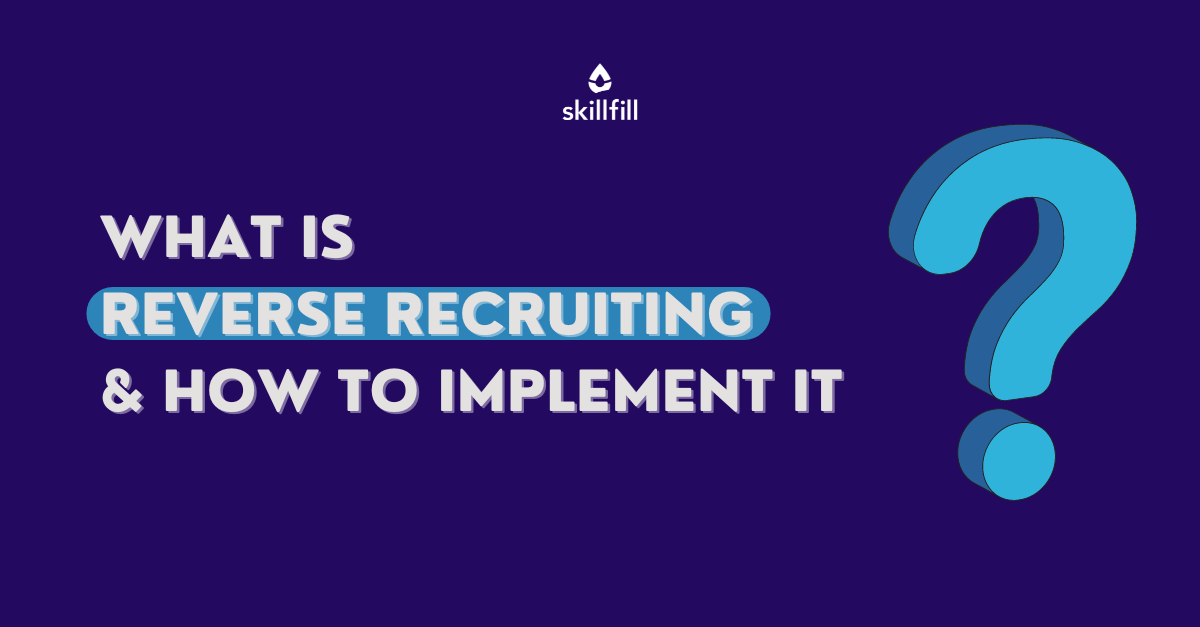Unlock the Power of Reverse Hiring Techniques for Effective Talent Procurement
In the realm of skill procurement, the landscape is continuously advancing, with new approaches emerging to satisfy the needs of an open market. Among these methods, reverse recruiting attracts attention as a technique that turns the traditional recruitment process on its head, putting the power in the hands of the prospects. By attracting leading talent to look for possibilities within your company, reverse recruiting supplies a fresh approach to bring in and maintaining key employees. As companies aim to stay in advance in the ability video game, opening the potential of reverse recruiting strategies could be the key to protecting a strong and dynamic workforce.
Comprehending Reverse Recruiting
Understanding reverse recruiting is critical in navigating the evolving landscape of ability procurement methods. Unlike typical employment techniques where employers choose prospects, reverse recruiting includes the aggressive strategy of prospects looking for prospective employers. This standard shift places candidates in the chauffeur's seat, allowing them to choose firms that line up with their values, occupation goals, and work choices.
Fundamentally, reverse recruiting empowers prospects to take control of their work search procedure by looking into firms, getting to out to employers or working with supervisors straight, and showcasing their skills and experiences. For companies, this technique provides a distinct opportunity to bring in top skill that are genuinely interested in the firm and its objective, fostering an extra engaged and devoted labor force.
Benefits of Reverse Hiring
Utilizing reverse recruiting approaches can yield considerable benefits for both prospects and employers in the ability acquisition process. By being come close to by companies who have currently identified them as prospective fits for their company, candidates can feel extra valued and looked for after.
In addition, reverse recruiting can aid companies differentiate themselves in an affordable skill market by showcasing an aggressive and forward-thinking strategy to employment. Eventually, the benefits of reverse recruiting expand to both candidates and employers by simplifying the hiring procedure and fostering even more meaningful links between the two events.

Executing Reverse Hiring Methods
To effectively integrate reverse recruiting methods into a talent acquisition technique, organizations should prioritize proactive engagement with potential prospects. This requires recognizing leading skill within the market and developing relationships with them before a real work opening up develops. One essential strategy is to utilize social media sites systems to attach with easy candidates that might not be proactively seeking new possibilities. By showcasing the firm society, values, and profession development chances, companies can pique the interest of potential prospects and construct a skill pipeline for future requirements.
Additionally, implementing tailored interaction techniques can likewise boost the effectiveness of reverse recruiting. By regularly supporting connections with top skill, companies can remain in advance in the competitive talent purchase landscape and safeguard the ideal prospects for their team - reverse recruiting.
Leveraging Technology in Reverse Recruiting
In the digital age of ability acquisition, taking advantage of technical developments is vital for effective implementation of reverse recruiting strategies. Leveraging technology in reverse recruiting provides many advantages to simplify the procedure and bring in leading skill successfully. Candidate monitoring systems (ATS) play an important function in handling candidate data, tracking interactions, and automating communication, allowing recruiters to concentrate on structure partnerships with possible hires.
In addition, leveraging artificial knowledge (AI) and equipment understanding can improve the candidate experience by personalizing interactions, evaluating large collections of information to determine suitable candidates, and forecasting future working with requirements. AI-powered chatbots can involve with prospects in real-time, providing instant support and event important information to read this article analyze prospect fit. Utilizing information analytics tools can aid recruiters determine the performance of their reverse recruiting techniques, identify locations for improvement, and make data-driven choices to optimize the talent procurement process. By welcoming innovation backwards recruiting, organizations can remain ahead in the affordable skill market and safe and secure top ability effectively.
Determining Success backwards Hiring
Having developed the foundational function of modern technology in optimizing reverse recruiting techniques, the following important action hinges on successfully gauging the success of these innovative methods. In the world of reverse recruiting, typical metrics like time-to-fill and cost-per-hire may not fully capture the effect of these methods. Rather, measuring success in reverse recruiting requires a much more nuanced strategy that concentrates on candidate involvement, company branding improvement, and lasting ability retention.
One key metric to think about is candidate experience. By collecting feedback from candidates who have undergone the reverse recruiting process, organizations can acquire important insights into areas for improvement and identify staminas to take advantage of. Furthermore, tracking metrics associated with employer brand perception, such as social media sentiment and Glassdoor reviews, can have a peek at these guys offer a much more holistic sight of just how reverse recruiting is forming the organization's online reputation in check the ability market.
Inevitably, success backwards recruiting must be measured not only by the performance of filling up functions however likewise by the quality of hires, their placement with business culture, and their long-term performance within the firm. By adopting a comprehensive approach to measuring success, companies can genuinely unlock the potential of reverse recruiting approaches for successful ability purchase.
Conclusion
